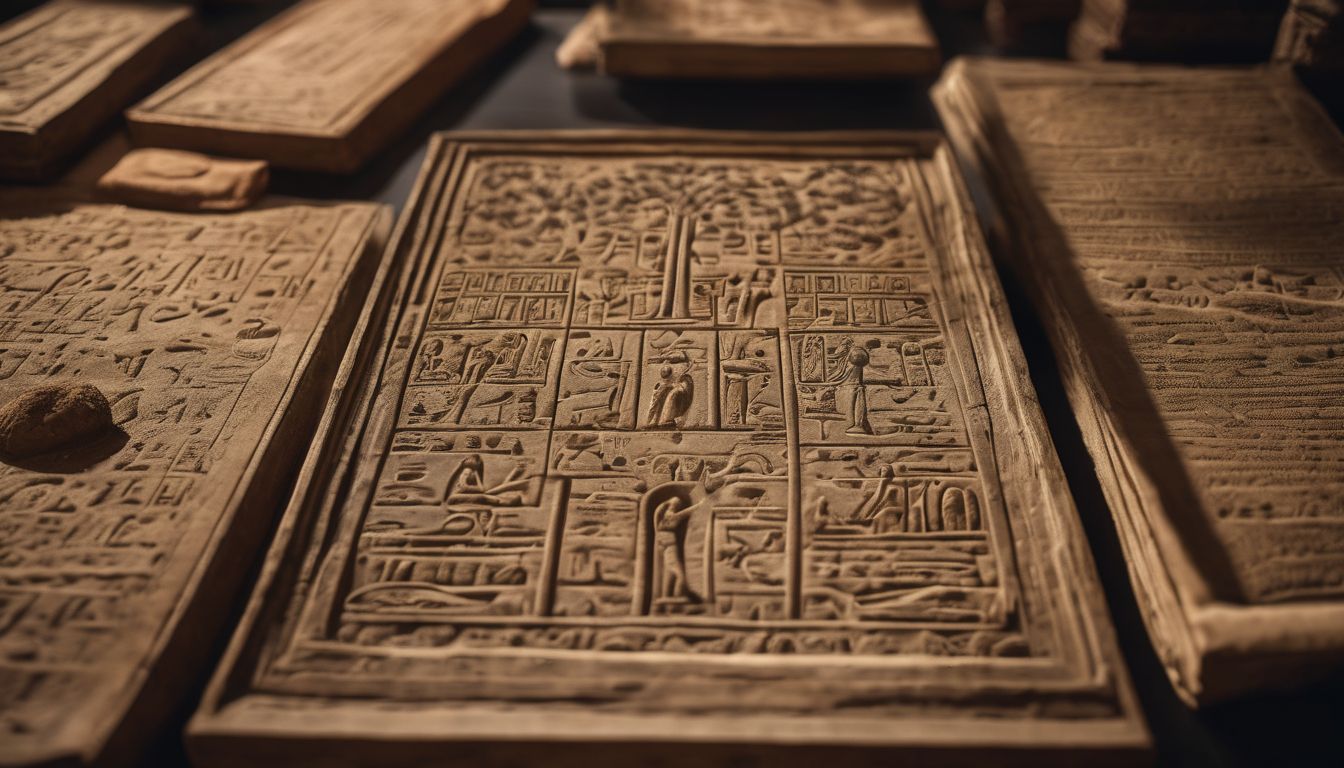Unraveling the intricacies of King Tutankhamun’s lineage plunges us into a past where royal bloodlines were astoundingly interwoven, reflecting customs far removed from our own. As an Egyptologist with years dedicated to studying the Eighteenth Dynasty of Ancient Egypt, my experience has given me profound insights into these regal connections that have baffled historians and enthusiasts alike.
From deciphering hieroglyphs to examining ancient remains, I believe piecing together Tutankhamun’s ancestry is key to understanding the pharaohs’ quest for maintaining divine rule.
The family tree of King Tut is not merely a genealogical chart; it’s a narrative steeped in power, mystique, and the complexities of dynastic politics. In this exploration, we’ll confront one intriguing revelation – DNA tests have confirmed that Pharaoh Akhenaten was indeed Tutankhamun’s father – reshaping how we view this lineage and its impact on history.
Prepare for an enlightening journey through time as we reveal secrets held tightly by desert sands for millennia.
Key Takeaways
- King Tutankhamun’s lineage is a complex narrative steeped in power, mystique, and the complexities of dynastic politics, confirmed through DNA tests that Pharaoh Akhenaten was indeed his father.
- The intricate web of familial relationships surrounding King Tut involves forefathers Thutmose IV and Amenhotep III, enigmatic figure Nefertiti, mysterious pharaoh Smenkhkare, as well as the debated identity of his mother.
- Incestuous practices within ancient Egyptian royalty led to severe genetic disorders and health issues for King Tutankhamun and high mortality rates among offspring – shedding light on historical implications of such inter-family marriages.
Unveiling the Family Tree of King Tut

Thutmose IV and Amenhotep III served as forefathers to King Tut, with Akhenaten being his enigmatic father and Nefertiti and Smenkhkare playing controversial roles in Tut’s lineage.
Thutmose IV and Amenhotep III: The Forefathers
Thutmose IV left an indelible mark on ancient Egyptian history, not simply through his rule but also through spiritual visions that heralded the sun-disk Aten. These revelations laid the groundwork for future religious shifts and played a significant role in shaping the religious landscape of Egypt.
His reign demonstrated early interactions with what would become a central figure for his descendants.
Amenhotep III‘s thirty-eight-year leadership is immortalized in the annals of time, renowned for prosperity and arts. His monumental works still echo greatness across millennia, including his final resting place in Tomb WV22 located in the Western Valley of the Valley of the Kings.
This pharaoh set precedents in architecture, culture, and governance that influenced generations to come—setting a high bar for those who followed him onto Egypt’s illustrious throne.
Akhenaten: The Enigmatic Father
Akhenaten stands out in history as King Tutankhamun’s father, confirmed through modern DNA testing. As Pharaoh, he famously turned the religious tide of ancient Egypt by worshiping Aten, the sun-disk, and promoted monotheism—a stark departure from the traditional polytheistic beliefs held for centuries.
His revolutionary ideas did not just stop at religion; Akhenaten moved Egypt’s capital from Thebes to his newly established city of Akhetaten (now known as Amarna), embodying his break with old ways.
The ruler’s personal life was equally complex and controversial. He had several wives, which muddied the royal lineage and fueled speculation about power dynamics within the palace.
This network of relationships entangled Queen Nefertiti and lesser-known figures like Kiya among others in a web that fascinates scholars to this day. The intrigue deepened with untimely deaths and unanswered questions—mysteries that surround Tutankhamun’s family story with an aura of enigma even millennia later.
Nefertiti and Smenkhkare: Controversial Figures in Tut’s Lineage
Nefertiti rises as one of ancient Egypt’s most intriguing figures, the great royal wife who captured hearts and imaginations alike. Married to Pharaoh Akhenaten, they ignited the Amarna Revolution, worshipping only the sun disk Aten—a sharp turn towards monotheism that rocked the polytheistic foundations of their world.
Her legacy is cemented by six daughters but shadowed by her inability to produce a male heir, leaving a mark on history with controversies still debated today.
Smenkhkare then enters this turbulent tale as a pharaoh shrouded in mystery. As potentially both son and brother-in-law to Nefertiti, his reign whispers through history’s pages—a mere moment lasting somewhere between one to three years before vanishing like a desert mirage.
Their stories intertwine within King Tutankhamun’s lineage—a web of power plays and familial intrigue where truth mingles with legend amid the golden sands of time.
Exploring Tutankhamun’s Immediate Family

King Tutankhamun’s immediate family includes his mysterious mother, whose identity has been a subject of debate among historians and researchers, and his wife and half-sister, Ankhesenamun.
King Tut’s Mother: The Mystery Woman
Unraveling the identity of King Tut’s mother has long been a challenge that intrigued Egyptologists worldwide. The discovery of her mummy, known as the “Younger Lady,” in Akhenaten’s tomb finally gave clues to this enigmatic figure.
DNA tests revealed she was not Kiya, as some had speculated, but instead another royal bloodline member who had been lost to history.
The truth behind Tutankhamun’s lineage emerged with evidence pointing to his parents being siblings; a common practice among pharaohs aimed at preserving the purity of their divine bloodline.
Unfortunately, this led to severe health issues and contributed to high mortality rates for their children, including Tut himself whose life ended abruptly at 19 years old. The complex dynamics within his family tree reflect the intricate and often hidden relationships woven into ancient Egyptian royalty.
Ankhesenamun: King Tut’s Wife and Half-Sister
Ankhesenamun, also known as Ankhesenpaaten, was not only King Tutankhamun’s wife but also his half-sister. Their union resulted in at least two stillborn daughters. Following Tut’s death, Ankhesenamun briefly married her father and later wed her own grandfather before disappearing from historical records.
Ankhesenamun’s complex familial relationships were a product of the intricate web of royal lineages during ancient Egypt’s 18th Dynasty. Her marriages to close relatives highlight the practice of incestuous unions within the royal family, which has sparked considerable interest among historians and researchers studying the health impacts and societal implications of such intermarriages.
The DNA Revelations and Historical Implications

The DNA analysis of King Tutankhamun’s mummy revealed evidence of inbreeding within his lineage, shedding light on the potential health implications and historical significance of this practice among ancient Egyptian royalty.
Incestuous Practices and Their Impact on Tut’s Health
Incestuous practices, common in the royalty of Ancient Egypt, had a detrimental impact on Tutankhamun’s health. His parents were full siblings, leading to severe genetic disorders and inherited maladies.
Tutankhamun’s skeletal remains reveal physical deformities and indications of frail health due to the effects of inbreeding. He suffered from numerous ailments such as malaria and bone necrosis, which can be attributed to his compromised immune system resulting from incestuous lineage.
The consequences of these practices were evident not only in Tutankhamun but also in high mortality rates among ancient Egyptians due to genetic defects caused by inter-family marriages.
Conclusion

Examining the family tree of King Tutankhamun offers intriguing insights into the complexities of ancient Egyptian royalty. Unveiling the lineage of King Tut unveils a tangled web of familial relationships, political maneuvering, and the impact of hereditary conditions on royal dynasties.
Through DNA revelations and historical discoveries, we gain a deeper understanding of how these intricate family ties influenced both the health and reigns of pharaohs, shedding light on an enigmatic era in history.
This exploration not only informs us about one specific royal lineage but also offers a window into the broader landscape of ancient Egypt’s illustrious past.
FAQs
1. Who were King Tut’s parents?
King Tut’s father was Pharaoh Akhenaten, also known as Amenhotep IV, and his mother is believed to be The Younger Lady found in tomb KV35, whose identity might be Queen Tiye or another of Akhenaten’s wives.
2. Did King Tut have any famous family members?
Yes, King Tut came from a line of notable pharaohs like Amenhotep III and had relatives such as Queen Meritaten and Pharaoh Smenkhare in the Eighteenth Dynasty of Egypt.
3. What makes King Tut’s family tree interesting?
King Tut’s family has ties to ancient Egyptian royalty including figures like Yuya and Tjuyu, Queen Tiye, and he changed his name from Tutankhaten to honor the god Amun instead of the Aten worship promoted by his dad.
4. Were there any queens in King Tut’s family tree?
Certainly! Notable queens include Ankhesenamen who married King Tut himself; Mutemwiya was his grandmother; Nebetah and Beketaten were possible aunts or sisters with royal connections.
5. How did beliefs about gods affect the names in King Tut’s family?
Beliefs significantly influenced their names – for instance, changing from Amun-focused ones like Amenhotep to Aten-centered ones like Akhenaten during revolutionary monotheistic reforms that favored one true god over traditional pantheons.
6. Is there anything special about where some of King Tut’s relatives are buried?
Many tombs including those for royalty such as high priest Anen or Horemheb showcase unique Amarna style art; Plus, treasure-filled places like intact tomb Luxor Temple reveal more about them.

Elizabeth Miller is a seasoned family tree researcher with over 16 years of expertise in tracing the genealogies of historical, celebrity, and well-known individuals. Holding relevant qualifications, they actively contribute to genealogy communities and have authored articles for prominent publications, establishing their authority in the field. Elizabeth Miller is dedicated to unraveling the intricate family histories of notable figures, helping clients discover their historical roots. Satisfied clients attest to their trustworthiness and the enriching experience of working with them. As a dedicated storyteller who brings history to life through genealogy, Elizabeth Miller is a reliable and authoritative source for those seeking to explore the family trees of historical, celebrity, and well-known personalities.

